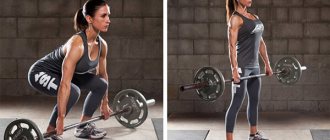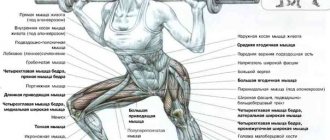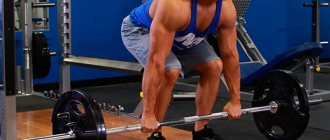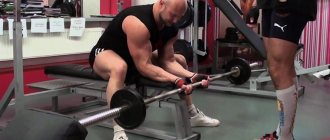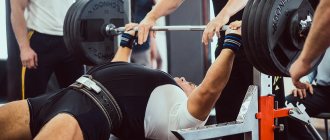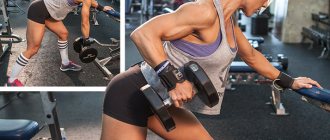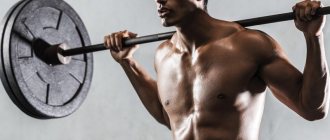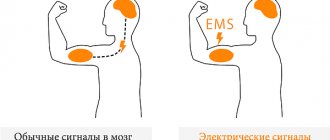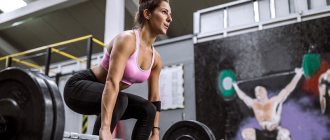On June 2-4, the WRPF European Championships in powerlifting (powerlifting), bench press, deadlift, folk bench press and powerlifting are being held in Moscow at the Russian State University of Physical Education. I decided to take part and compete in the weight category up to 75 kg with doping control (DK, “in kind”), an open age group for the first category in the bench press (105 kg) and the first category in the deadlift (155 kg), so that there was an incentive to further storm the KMS and MS. I bench pressed 107.5kg on my final bench press attempt and pulled 167.5kg on my final deadlift attempt. In both movements there was a reserve of up to 110 kg and 170 kg respectively.
I’ve been training independently in weightlifting and powerlifting for 2 years now, so I’m creating my own program and preparing for competitions. This material is a self-report on the work done, and readers may be interested in how novice athletes start in order to compare their programs; More experienced athletes will find it fun to twirl their finger at their temple at some points and remember themselves at the first start ;-)
Start.
I started preparing on January 10, 2020, after I had the flu during the New Year holidays. Therefore, the first cycle was for recovery for two weeks, until January 23-25. Weightlifting exercises work the entire body, especially strengthening the back, legs and shoulder girdle.
- note: my weight up until the European Championships fluctuated from 75.5 to 71.5 kg closer to the competition, so I will not indicate it in the future.
- note 2: the maximum I benched before the start of training was 100x2, the maximum I pulled was 152.5 kg
Recovery workout:
- Warm-up for all joints, stretching elements.
- Hyperextension, 4 sets of 8-10 reps with bodyweight, with a small bar 12-15 kg, with an Olympic bar 20 kg as recovery progresses.
- Overhead squats, 3 sets of 4 reps with barbell (20 kg), 40, 50 kg as recovery progresses.
- Squats with a barbell on the shoulders 4 sets of 5 reps with a weight of 40-60 kg.
- Bent-overs with a barbell, 3 sets of 6 reps with a weight of 50 kg.
- Snatch work with the bar: snatch pulling the bar, snatch moves into a low squat, deadlift, snatch from hanging from the groin, from the knee, from the platform.
- Stretching.
Examples of execution techniques:
Hyperextension
Overhead squats
Squats with a barbell on your shoulders
Bent-overs with a barbell
By January 25th, I was in good enough shape to begin benching, squatting, and deadlifting.
Basic cycle 1.
The task of the first basic cycle was to raise the working weights in the squat from 70-90 kg to 100-110 kg, in the bench press from 70-80 kg to 80-90 kg, and in the deadlift from 110-120 kg to 130-135 kg. In addition, it was necessary to train general endurance in order to stop experiencing fatigue during training and protect yourself from overtraining.
On March 25, a powerlifting competition was supposed to be held in our gym, I decided to use it as an intermediate result in preparation for the WRPF-2017 European Championship.
From January 25 to March 1, a typical training week looked like this.
Monday.
- Warm-up with elements of stretching and hyperextension 3x10 with body weight.
- Squat with a barbell on the shoulders, 8 sets of 3-5 reps: 70x5, 80x5, 80x5, 90x5, 90x4, 90x4, 80x5, 90x3. Those. the upper working weight was the main one.
- Bent-overs with a barbell, 5 sets of 6 reps with 60-80 kg: 60x6, 70x60, 80x6, 80x6, 70x6.
- Hyperextension with a 20 kg bar, 4 sets of 8 reps.
- Snatch work with a bar: snatch stretch to squat, snatch from hanging from the groin, from the knees, from the platform 3+3 sets of 4-5 reps
- Stretching
Tuesday.
Exercise bike at home, 30 minutes, average speed 43-44 km/h throughout, heart rate within 120-140 beats per minute, distance 20-21 km.
Wednesday.
- Warm-up with elements of stretching and hyperextension 3x10 with body weight.
- Squat with a barbell on the shoulders, 5 sets of 5 reps with 70 kg.
- Bench press, 6 sets of 4-5 reps with a weight of 70-80 kg: 70x5, 75x5, 80x5, 80x5, 80x4, 75x5.
- Shvung push, 4 sets of 3 repetitions with a weight of 50-60 kg.
- Dips with body weight (73-74 kg at that moment), 4 sets of 8-10 reps.
- Stretching.
An example of performing the push and pull exercise:
Thursday.
Exercise bike at home, 30 minutes, average speed 43-44 km/h throughout, heart rate within 120-140 beats per minute, distance 20-21 km.
Friday.
- Warm-up with stretching elements and hyperextension 3x10 with a 20 kg bar.
- Classic deadlift. One week I did 6 sets, the second 8. Week 1: 70x5, 90x5, 100x5, 110x5, 120x5, 120x5. Week 2: 70x5, 100x5, 110x5, 120x5, 120x5, 120x5, 120x5, 100x5.
- Leg press, 4 sets of 5 reps with a weight of 170-200-250 kg.
- Horizontal block rows, 4 sets of 5 reps with a weight of 70 kg.
- Vertical rows, 4 sets of 5 reps with a weight of 70 kg.
- Stretching.
Saturday.
- Warm-up with elements of stretching and hyperextension 3x10 with body weight.
- Bench press, 8 sets with 70-75 kg.
- Shvung press 4 sets of 4 reps with a weight of 50-75 kg.
- Push-ups on parallel bars with a weight on the belt of 15-25 kg, 8-10 repetitions.
- Stretching.
As you can see, I used some weightlifting exercises, like the push push and push press. They perfectly develop explosion, serve from the feet and strengthen the shoulder girdle. The general point of training in the basic cycle was to lift the working weights as much as possible in the allotted time.
One more note : I always perform the bench press with a pause of 2-3 seconds, with a reserve so that there are no problems during competitions. This complicates the training, but in the future it gave results.
By March 1, the task was completed. In addition, the exercise bike helped strengthen my heart, improve my functionality, and I stopped feeling tired during workouts.
Alternative Deadlift Exercises
What can replace deadlifts? I’ll say right away that the following information is intended for those athletes who cannot perform deadlifts due to medical contraindications, but want to work target muscle groups using other exercises.
For everyone else, the answer is: NOTHING.
The deadlift is a multi-joint exercise that uses almost all the muscles in our body. And the effect it has on our strength and muscle mass can hardly be replaced by hyperextensions, barbell bends, or exercises for the hip adductors. Therefore, if you cannot perform deadlifts because axial load on the spine is contraindicated for you, include the following exercises in your training process:
- Pull-ups on the bar – probably the best exercise in the world for gaining back muscle mass and creating a V-shaped silhouette. It is important to try to carry out the movement by contracting the latissimus muscles, bringing and spreading the shoulder blades, while minimally including the forearms and biceps. This way you will get maximum efficiency from this exercise. Perform other lat exercises where the axial load is minimal (wide-grip vertical pull-down, close-grip horizontal pull-down, overhead pullover, hummer row, etc.) in order to put more stress on the muscles and create the preconditions for growth of muscle mass.
© Makatserchyk — stock.adobe.com
- Hyperextension – an exercise that perfectly develops the main muscle group that works during the classic deadlift – the spinal extensors. It is noteworthy in that the axial load in it is practically zero, therefore it is strongly recommended to be performed not only as an alternative to the deadlift, but also as an addition to it, and as a general strengthening preventive exercise, and as an exercise aimed at rehabilitating an injured lower back.
© Makatserchyk — stock.adobe.com
- Reverse hyperextensions – a type of hyperextension where the athlete contracts the target muscle group by lifting the legs rather than the body. The load here is more directed at the lower part of the spinal extensors; the sacrum area receives the maximum blood flow.
- Advances and flyes while sitting in the simulator – exercises with which you can separately load the adductor muscles of the thigh and buttocks without axial load on the spine. Therefore, if the sumo deadlift is contraindicated for you, you may well include these two exercises in your arsenal.
© Makatserchyk — stock.adobe.com
Formative cycle 1.
On March 1, I began to formulate the upcoming result for the competition on the 25th. I switched to working for 3, 2 and 1 repetitions, increasing the weight in each exercise. I reduced the exercise bike to once a week in the first 2 weeks of March, then removed it. The training began to look like this.
Monday.
- Warm-up with elements of stretching and hyperextension 3x10 with body weight.
- Squat with a barbell on the shoulders, 8 sets of 3, 2, 1 reps: 70x4, 90x3, 100x3, 100x3, 105x2, 110x2, 105x2, 90x3.
- Bent-overs with a barbell, 5 sets of 6 reps with 50 kg.
- Stretching.
Tuesday.
Exercise bike at home, 30 minutes, average speed 43-44 km/h throughout, heart rate within 120-140 beats per minute, distance 20-21 km.
Wednesday.
- Warm-up with elements of stretching and hyperextension 3x10 with body weight.
- Squat with a barbell on the shoulders, 5 sets of 5 reps with 70 kg.
- Bench press, 6 sets of 3, 2 reps: 70x5, 80x3, 85x3, 90x2, 90x2, 85x3.
- Bodyweight dips, 4 sets of 8-10 reps.
- Stretching.
Friday.
- Warm-up with stretching elements and hyperextension 3x10 with a 20 kg bar.
- Classic deadlift, 8 sets: 70x5, 100x3, 120x3, 130x3, 135x3, 130x3, 140x2, 120x3.
- Stretching.
Saturday.
- Warm-up with elements of stretching and hyperextension 3x10 with body weight.
- Bench press, 8 sets: 70x5, 80x5, 90x3, 90x2, 90x2, 80x3, 90x2, 80x3.
- Bodyweight dips, 8-10 reps.
- Stretching.
The load in the competitive exercises increased, I removed the heavy auxiliary exercises, leaving the lighter ones.
In the third week of March, I did walkthroughs of all movements, squatting 125 kg, benching 102.5 kg three times for 1, and pulling 155 kg for 1.
I rested for 5 days before the competition.
3. Work on the bottom and top of your deadlift range
In the deadlift you need to be strong throughout the entire range of motion - both at the bottom and at the top. If you have problems in the lower part of the amplitude or in the upper, then include exercises in the program to eliminate weaknesses.
Add sets of auxiliary rows of 5-8 reps after your main working sets of deadlifts. From time to time, try heavy triples and even singles (sets of one repetition), replacing regular deadlifts with them.
For the upper section, it is best to pull from the plinths (when the bar is mounted with weights on blocks). If you don't have special boxes for this, add pancakes or use step pads. This option is more effective than partial deadlifting in a power rack or from racks where the bar rests on clamps. When the plates are on the plates, the movement is more similar to a regular deadlift, which is positively transferred to the result in the full range.
An example of a deadlift with plates for training the upper part of the range:
To break down and practice acceleration from the bottom point, do deadlifts from the pit (standing on a hill). Place just one weight plate under your feet and you will immediately feel how much harder it is to pull. But this makes this option very useful if you have problems getting started. Moreover, there is no need to use heavy weights or a stand that is too high. You only need to go up a few centimeters to get a significant increase in the normal range.
Example of a low-elevation deadlift to train the lower end of the range:
Competition on March 25.
Competitions were held in our hall. Due to the shift in deadlines and the lack of participants, I managed to warm up in the squat twice, using up some strength.
I did squats 110, 115, 122.5 kg, bench pressed 90, 95, 102.5 kg. And then my back muscles cramped due to the fact that I did not invest enough in moving my legs and pelvis, but squeezed with my muscles.
I had to pull 130, then 140 kg with a crooked back. I thought about giving up the third approach if it weren’t for the lovely competitor who cheerfully said to me, “Aren’t you even going to try?).” What man wouldn't take a risk after such a challenge, huh? With a belt, a hump, I could barely carry 150 kg.
Based on the results of the competition, I came to the conclusion that in the upcoming basic cycle we need to focus on competitive movements.
Basic cycle 2.
The task in this cycle was from April 1 to May 1 to make the weights from the past formative cycle work. Therefore, I concentrated all my efforts on competitive exercises, leaving light assistance. Because I planned to perform on the bench press and deadlift, so I made the squat an auxiliary, albeit important, exercise.
Monday.
- Warm-up with elements of stretching and hyperextension 3x10 with body weight.
- Squat with a barbell on the shoulders, 8 sets of 3, 2, 1 reps: 70x4, 90x3, 100x3, 110x3, 110x2, 115x2, 120x1, 110x2. Sometimes I walked 115x2/1 for two approaches, sometimes I walked 120x1 twice, three times, trying in every possible way to raise the upper bar.
- Bent-overs with a barbell, 5 sets of 6 reps with 50 kg.
- Stretching.
Tuesday.
Exercise bike at home, 30 minutes, average speed 43-44 km/h throughout, heart rate within 120-140 beats per minute, distance 20-21 km.
Wednesday.
- Warm-up with elements of stretching and hyperextension 3x10 with body weight.
- Bench press, 6 sets of 4, 3 reps: 70x5, 80x5, 90x4, 90x4, 90x3, 90x3. Of course, I did not come to this result immediately, but after about 2 weeks.
- Bodyweight dips, 4 sets of 8-10 reps.
- Stretching.
Friday.
- Warm-up with stretching elements and hyperextension 3x10 with a 20 kg bar.
- Classic deadlift, 8 sets: 70x5, 100x5, 120x5, 130x4, 135x4, 130x4, 135x2, 130x2.
- Stretching.
Saturday.
- Warm-up with elements of stretching and hyperextension 3x10 with body weight.
- Bench press, 8 sets: 70x5, 80x5, 90x4, 90x4, 90x4, 95x3, 95x3, 80x3. I came to these results after 3 weeks of April. But every workout I tried to achieve results with more repetitions per set and more weight.
- Bodyweight dips, 8-10 reps.
- Stretching.
I achieved my goals by the May holidays and moved on to formation cycle 2.
Task 1. Determination of arm muscle strength in men and women
The purpose of the study is to measure and compare muscle strength in the right and left arms and in men and women.
General information
Determining the strength of muscle tension is one of the most common techniques in the field of psychophysiology. The tension developed by a particular muscle or group of muscles is a functional characteristic of the locomotor system and is considered as a general indicator of the physical development of an individual. When studying muscle strength, indicators of deadlift strength (the strength of the muscles that straighten the bent torso), strength of the legs, arms, and fingers are differentiated. According to published data, in right-handed men who do not experience intense physical activity, the strength of the right hand is about 39 kg, and the left - 36 kg. For women, the values of these indicators are respectively 22 and 20 kg [13].
When analyzing muscle strength indicators, the following general information must be taken into account.
• Muscular strength is a highly trainable property. Therefore, under the influence of physical activity experienced by a person in the process of sports, professional or even household activities, muscle strength increases significantly.
• In most people (right-handed), the strength of the right hand is greater than the strength of the left; the severity of the asymmetry averages 4-8% of the magnitude of muscle strength. The lack of differences in the muscle strength of the two hands may be due to both individual characteristics of motor skills (ambidexterity) and the influence of additional physical activity on the left hand.
• Muscle strength changes with age. The greatest muscle strength is observed at the age of 20-30 years. It remains unchanged until approximately 40 years of age, and then declines steadily, and in women this decline occurs more rapidly than in men.
Equipment: hand dynamometer
Operating procedure
In this paper, it is proposed to measure hand strength using a spring wrist dynamometer. The study is carried out in a sitting position on a chair. The subject is given the instruction “Sit up straight, take the dynamometer in your right hand, place your left hand on your knee. Squeeze the dynamometer with your right hand to the limit (with maximum effort). At the same time, your right arm is bent at the elbow joint and extended forward.” After measuring the strength of your right hand, measure the strength of your left hand in a similar way. Enter the results obtained in the table. 1.
Table 1
The magnitude of muscle strength of the right and left arms in groups of men
And women (kg)
| item number | Men | Women | |
| right arm strength | left arm strength | right arm strength | left arm strength |
| Group average |
Before proceeding to the analysis of the measurement results, it is necessary to determine the average values of muscle strength for the right and left arms in groups of men and women. The results obtained are compared with the data given in the “general information”, that is, the age of the subjects, the role of physical activity in their lives are taken into account, and attention is drawn to differences in the strength of the right and left hands. There is a difference in muscle strength between men and women. The higher rates of muscle strength in men are consistent with the general trend, since in most cases men are stronger than women. However, in a particular study group, other results may be obtained, that is, arm strength indicators in women are equal or higher than in men. In this case, it is necessary to turn to the analysis of the life activity characteristics of the subjects (presence or absence of physical activity) and pay attention to the possibility of strength training in the process of individual development.
Task 2. Study of interhemispheric asymmetry (determination of the leading hemisphere) in men and women
Objectives of the study. To conduct a comparative assessment of the dominant hemisphere in groups of men and women (to determine the predominant type of interhemispheric asymmetry), compare the results obtained with data on the superiority of men in understanding spatial relationships and the better development of speech functions in women.
General information
Functional asymmetry lies in the fact that in the implementation of some mental functions the left hemisphere dominates, while others - the right. The right hemisphere controls the motor functions of the left half of the body, and the left hemisphere exercises similar control over the right half of the body. The left hemisphere is responsible for speech, time analysis, carries out sequential signal processing, and is associated with the analysis of abstract features and logical thinking. Since most people are right-handed, that is, the dominant hand is the right, the left hemisphere is considered the leading hemisphere for motor control. The main functions of the right hemisphere are the analysis of spatial features, parallel processing of information, and imaginative thinking. There is evidence about the role of the hemispheres in the formation of emotions [17]. The left hemisphere specializes in the formation of positive emotions, the right is associated primarily with negative emotions.
Each individual may have a predominance of the functions of one of the hemispheres, which is reflected in the characteristics of cognitive processes and the emotional and personal sphere. For example, individuals with dominance of the right hemisphere are more likely to display an imaginative type of thinking, solve visual-figurative tasks more successfully, and have higher rates of neuroticism and anxiety. In left-hemisphere people, sign-logical thinking and a positive emotional background predominate. Researchers have not reached a consensus regarding the gender characteristics of interhemispheric dominance. A number of studies have found that the predominance of the left hemisphere is more common in men than in women. Along with this, there is evidence that there are no pronounced differences between men and women in interhemispheric asymmetry. The features of interhemispheric interaction are genetically programmed, but the conditions of individual development contribute to or hinder their normal formation.
There are various ways to determine the dominant hemisphere - by the dominant hand, dominant eye, ear, etc. In this work, it is proposed to use a comprehensive method for determining the dominant hemisphere by performing several tests assessing the leading eye, leading hand and leading leg [21].
Equipment: table “Evaluation of the leading hemisphere”, stopwatch, sheet of unlined paper.
Operating procedure
The subject is asked to perform tasks sequentially, then evaluate each task and determine the dominant hemisphere. Tasks, criteria and assessments are given in table. 2.
table 2
Assessment of the leading hemisphere
| Job in progress | Assessment of the leading hemisphere |
| 1. Interlace your fingers | Above, the thumb of the right hand is the leading hemisphere of the left, above the thumb of the left hand is the right |
| 2. The subject holds a pencil vertically in an outstretched hand, fixing it with his gaze on a certain point, alternately closing the right or left eye | The pencil will mix when you close your right eye—the dominant hemisphere is the left. The pencil will mix when closing the left eye - the leading hemisphere is the right |
| 3. Imitate Napoleon's pose | The hand of the left hand is the first to go to the forearm-shoulder of the right hand and ends up on top - the leading hand is left, the leading hemisphere is right, the right hand is the first to go to the forearm-shoulder of the left hand - the leading hand is right, the leading hemisphere is left |
| 4. Imitate applause | The right hand is on top - the leading hemisphere is the left, the left hand is on top - the leading hemisphere is the right |
| 5. Draw a straight vertical line dividing a blank sheet of paper in half | The line closer to the right edge of the sheet is the leading hemisphere is right, the line closer to the left edge of the sheet is the leading hemisphere is left |
| 6. Draw a triangle and a square first with your left hand, then with your right hand | Figures are better drawn with the right hand - the leading hemisphere is left, better drawn with the left hand - the leading hemisphere is right. |
| 7. Place an arbitrary number of sticks with your left hand, and then with your right hand. The task completion time is 10 s. Count the number of sticks | More sticks are placed with the right hand - the leading hemisphere is left, with the left hand - right, the same number with both hands - right |
| 8. Draw a circle, completing it with arrows | The arrow indicates the direction counterclockwise - the leading hemisphere is left, clockwise - the right |
| 9. Sitting on a chair, cross your legs | From above the right leg is the leading hemisphere of the left, from above the left leg is the right |
| 10. While standing, spin in a comfortable direction | Spins counterclockwise - the leading hemisphere is left, spins clockwise - right |
| 11. Blink one eye quickly | The right eye blinks faster - the leading hemisphere is right, the left eye - the left. The non-dominant eye blinks faster. |
The final score is calculated as follows: the difference between the sum of the left hemisphere scores and the sum of the right hemisphere scores is divided by 11. The results are compared with the given normative data.
The resulting indicator is:
1) greater than or equal to 30 - complete dominance of the left hemisphere;
2) from 10 to 30 - incomplete dominance of the left hemisphere;
3) from 10 to -10 - incomplete dominance of the right hemisphere;
4) below -10 - complete dominance of the right hemisphere.
When generalizing the results obtained, we can combine into one group individuals with complete and incomplete dominance of the left hemisphere (predominantly left hemisphere) and, accordingly, individuals with complete and incomplete dominance of the right hemisphere (predominantly right hemisphere). Present the obtained data in the form of a table. 3.
Table 3
Right or left hemisphere dominance
in men and women
| Dominant hemisphere | Men | Women |
| Left | ||
| Right |
To clarify individual results, you can compare them with dynamometry data. Typically, greater muscle strength corresponds to the dominant arm. Moreover, if the stronger hand is the right one, then we can assume that the left hemisphere is dominant and, accordingly, vice versa. For additional assessment of the leading hemisphere, you can ask to remember whether the person being examined has left-handers or ambidextrous people among their close relatives. Considering that the type of interhemispheric dominance is inherited in most cases, the presence of left-handed or ambidextrous relatives indicates possible dominance of the right hemisphere. However, these data should be considered as additional and the main attention should be paid to the test results.
When analyzing the results, it is necessary to pay attention to the presence or absence of differences associated with gender. During the task, data can be obtained showing the predominance of left hemispheres among both men and women. If there are more left-hemisphere people among men, then during the discussion it is necessary to emphasize that the issue of the leading hemisphere in men and women has not been finally resolved, the results of research on this issue are contradictory. If there are more left-hemisphere people among women, the discussion can be framed in the context of analyzing the contradictions between real life practices and existing stereotypes about the logical type of thinking of men and the imaginative type of thinking of women.
You should also pay attention to the connection between the functional specialization of the hemispheres and speech and cognitive processes. High success in performing verbal activity correlates with the left-hemisphere type, and accordingly, individuals with right-hemisphere dominance are most successful in completing spatial orientation tasks. It is known that the established psychological differences between the sexes are the superiority of women in the development of speech functions and the superiority of men in visuospatial abilities. The lack of clear information about sex differences in interhemispheric specialization does not provide grounds for recognizing the priority of the biological factor in the sexual differentiation of abilities. Compared to the biological, sociocultural determination of differences plays a more significant role in the development of visual-spatial and speech abilities of men and women, that is, biological sex itself does not strictly determine the characteristics of psychological differences.
Control questions
1. How are the concepts of sex and gender interconnected?
2. What is sexual dimorphism?
3. What gender differences have been established in somatic properties and how can they influence the social behavior of men and women?
4. In what psychophysiological properties of men and women have significant differences been identified, and in what properties have no significant differences been established?
5. What psychophysiological properties are influenced by sociocultural factors?
6. What is the connection between sex differences in the cognitive sphere and the functional specialization of the cerebral hemispheres?
7. What is the significance of the study of sex differences in the psychophysiological sphere for the development of gender psychology?
Literature
1. Aruin A. S., Zatsiorsky V. M.
Ergonomic biomechanics. - M.: Mechanical Engineering, 1989.
2. Bulaeva K. B.
Genetic basis of human psychophysiology. - M.: Nauka, 1991.
3. Woodson W., Conover D.
Handbook of engineering psychology for engineers and design artists. - M.: Mir, 1968.
4. Gurevich M., Ozeretsky N.
Psychomotor. Part 1. Anatomical and physiological foundations of psychomotor skills and its relationship with physique and character. - M.; L.: State. honey. publishing house, 1930.
5. Eremeeva V.D., Khrizman T.P.
Boys and girls: two different worlds. - St. Petersburg: Publishing house, 1998.
6. Ivanitsky M. F.
Human anatomy. - M.: FiS, 1966.
7. Ilyin E. P.
Differential psychophysiology (human capabilities and properties of the nervous system). - Chelyabinsk, 1999.
8. Kimura D.
Sexual differences in the organization of the brain // In the world of science.-1992.-No. 11-12.-P. 73-80.
9. Milner P.
Physiological psychology. - M.: Mir, 1973.
10. The beginnings of physiology / Answer. ed. A. D. Nozdrachev. - St. Petersburg: Lan, 2001.
11. Nikolaeva E.
Man and woman through the eyes of a psychophysiologist // Floor ceiling: Sat. articles / Ed. T. V. Barchunova. - Novosibirsk, 1998. - P. 11-44.
12. Panferov V. N.
Human psychology. - St. Petersburg: V. A. Mikhailov Publishing House, 2000.
13. Psychodiagnostic methods (in a complex longitudinal study of students) / Rep. ed. A. A. Bodalev. - L.: Leningrad State University Publishing House, 1976.
14. Development of psychophysiological functions of adults (middle adulthood) / Rep. ed. B. G. Ananyev, E. I. Stepanova. - M.: Pedagogy, 1977.
15. Slobodchikov V. I., Isaev E. I.
Human psychology: an introduction to the psychology of subjectivity: A textbook for universities. - M.: Shkola-Press, 1995.
16. Springer S, Deitch G.
Left brain, right brain. - M.: Mir, 1983.
17. Khamskaya E.D., Batova N.Ya.
Brain and emotions. - M.: Russian Pedagogical Agency, 1997.
18. Khomskaya E.D., Efimova I.V. et al.
Neuropsychology of individual differences. - M.: Russian Pedagogical Agency, 1998.
19. Reader on the anatomy of the central nervous system / Rep. ed. L. K. Khludova. - M.: 1998.
20. Scherrer J.
Physiology of work (ergonomics). - M.: Medicine, 1973.
21. Yassman A.V., Danyukov V.N.
Fundamentals of child psychopathology. - M.: Olympus "INFRA-M", 1999.
Chapter 4
Formative cycle 2.
I had 3 weeks for conditioning and a week and a half for competition pre-training. We had to try to raise the bar of working scales as high as possible and see what would come of it...
Monday.
- Warm-up with elements of stretching and hyperextension 3x10 with body weight.
- Push and lift rows, 4 sets of 4 reps with a weight of 70-100 kg. A very good exercise for explosive strength from weightlifting, I don’t understand why lifters who pull in classics don’t use it.
- Bent-overs with a barbell, 5 sets of 6 reps with 50 kg.
- Stretching.
Push traction technique with detonation.
Wednesday.
- Warm-up with elements of stretching and hyperextension 3x10 with body weight.
- Bench press, 6 sets of 3, 2, 1 reps: 70x5, 90x3, 100x3, 100x2, 100x2, 90x2.
- Incline Dumbbell Press, 4 sets of 10 reps with 22kg, 24kg dumbbells.
- Stretching.
Friday.
- Warm-up with stretching elements and hyperextension 3x10 with a 20 kg bar.
- Classic deadlift, 8 sets: 70x5, 100x3, 120x3, 130x3, 140x3, 140x3, 140x3, 120x3.
- Leg press. It should be noted here that we have two leg press machines in our gym. I started using this one:
In this simulator I sharply gained weight. I did 6-8 sets of 4-5 repetitions. Week 1: 170, 200, 250, 300, 300, 300; Week 2: 200, 250, 300, 350, 400x3, 400x3, 400x3, 420x3; Week 3: 170, 250, 250, 250, 300x5, 300x9 (I showed off in front of my friend who did this weight 8 times :D).
4. Stretching.
Saturday.
- Warm-up with elements of stretching and hyperextension 3x10 with body weight.
- Bench press, 8 sets: 70x3, 90x3, 100x3, 100x2, 100x2, 102.5x1, 105.1, 100x1.
- Bodyweight dips, 8-10 reps.
- Stretching.
At the end of the third week of May, I already reached 107.5 kg in the bench press. In the last week I managed to go through this weight twice, doing 3 single repetitions. In the deadlift I managed to lift up to 160 kg three times on a hard bar, reaching two single repetitions. And then my right elbow started to hurt...
Deadlift dynamometry and dynamography
Deadlift dynamometry - measuring the strength of muscle groups that straighten the torso. The lower bar of the deadlift dynamometer should be fixed under the feet of the subject. The subject grabs the top bar with his hands and pulls up. At the same time, he tries to straighten up with his lower limbs straightened at the knees.
In addition to deadlift, reverse and manual spring dynamometers, there are mercury devices in which muscle strength is determined as the level of pressure on the sensor using a mercury manometer.
European Championship WRPF 2020.
On June 2 I went to the competition. I went to bed at midnight, woke up around 7.30, ate buckwheat with milk, and loaded up with condensed milk. Slept from 10 to 11, had lunch with pasta and a piece of turkey, and loaded up with a second socket of condensed milk.
The bench press was scheduled to begin at 5:10 p.m. and the deadlift at 7:40 p.m. I was at RGUFK at 15.00, I met two friends there from our gym, one of whom performed in lifting. I slowly warmed up for the bench press. All the worries went away as soon as I arranged my things and looked around - the atmosphere in the hall was so friendly. Everything is going exactly according to the regulations, a huge, spacious hall in which weightlifting was held at the 1980 Olympics. Professional equipment, professional hardware, secretariat, judges.
I talked with my opponents and found out that I couldn’t fight for a prize place - all were Candidates of Masters and Masters of Masters, so I decided to limit myself to 107.5 kg. Unlike others, I was not worried at all, I pressed all three approaches, finishing with the planned weight. It was possible to do 110, but my elbow was starting to hurt, plus I needed strength to pull. There is the first category in the bench press, hurray!
Before the cravings I managed to watch a few performances and have a snack. I warmed up on time and left on time. I confidently took 150 kg, and just as confidently 160. I had an opponent who failed 170 kg on his second attempt. The problem arose: go for the dubious 170 or take 167.5? My friends and I decided on the second one, and pulled it off with some difficulty. The opponent took 170 on the third approach, with great effort, but he got it - it was a sin not to congratulate the guy on a small victory, but to say to himself that if you can take risks, go to the end.
There is the first category in deadlift, hurray!
Deadlift records
One way or another, the current absolute record in deadlift belongs to Icelander Benedikt Magnusson (weight category over 140 kg). He conquered 460 kg. There are two more equally impressive records, but they were performed using straps and overalls. However, this does not detract from their importance:
- Briton Eddie Hall conquered 500 kg (weight category over 140 kg), watch the epic video of this event below;
- Russian Yuri Belkin won 450 kg (ATTENTION, weight category up to 110 kg).
Which of these is more significant for the development of sports as a whole and setting the right example for novice athletes, decide for yourself. My opinion is the following: Belkin’s result is simply space. We wish the athlete to set new world records and avoid injuries.
